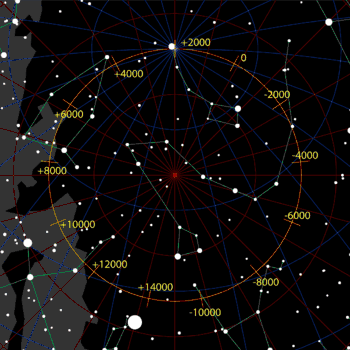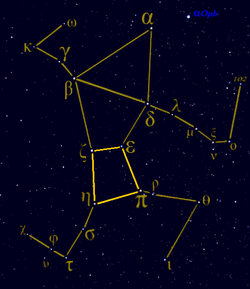Tau Herculis
| Observation data Epoch J2000 Equinox J2000 | |
|---|---|
| Constellation | Hercules |
| Right ascension | 16h 19m 44.4368s[1] |
| Declination | 46° 18′ 48.119″[1] |
| Apparent magnitude (V) | 3.89[1] |
| Characteristics | |
| Spectral type | B5 IV[1] |
| U−B color index | -0.57[2] |
| B−V color index | -0.155[2] |
| Astrometry | |
| Radial velocity (Rv) | -13.8[1] km/s |
| Proper motion (μ) | RA: -13.15[1] mas/yr Dec.: 39.31[1] mas/yr |
| Parallax (π) | 10.37 ± 0.53[3] mas |
| Distance | 310 ± 20 ly (96 ± 5 pc) |
| Absolute magnitude (MV) | −0.96[4] |
| Details | |
| Mass | 4.9[5] M☉ |
| Radius | 3.55±0.19[6] R☉ |
| Luminosity | 574[4] L☉ |
| Surface gravity (log g) | 4.02±0.05[6] cgs |
| Temperature | 15,615±301[6] K |
| Metallicity [Fe/H] | 0.15[7] dex |
| Rotational velocity (v sin i) | 46[8] km/s |
| Age | 1[5] Gyr |
| Other designations | |
| Database references | |
| SIMBAD | data |
Coordinates: ![]()
Tau Herculis, Latinized from τ Herculis, is a fourth-magnitude star in the constellation Hercules. It is a blue subgiant star, seven hundred times more luminous than the Sun.
Properties
Tau Herculis has a stellar classification B5IV. Its mass is 4.9 times solar.[5] Though its apparent magnitude is only 3.89, like all B-class stars, it is very luminous, boasting a total bolometric luminosity that is 700 times solar.[5] Hipparcos estimated its distance at roughly 96 parsecs from Earth, or 310 ± 20 light years away.
Pole Star

Tau Herculis is a visible star located within 1° of the precessional path traced across the celestial sphere by the Earth's North pole. It was the northern pole star around the year 7400 BC, a phenomenon which is expected to reoccur in the year 18,400 due to precession.[5]
The current pole star is, of course, Polaris. Among the 14 stars that could be reasonably considered eventual northern pole stars, Tau Herculis is the dimmest, but only Polaris itself and Thuban are closer to the precessional path.
| Preceded by | Pole Star | Succeeded by |
|---|---|---|
| Iota Herculis | 18,400 AD | Edasich |
Etymology
Its traditional name, Rukbalgethi Shemali, is of Arabic origin and shares certain etymological characteristics with the stars Ruchbah and Zubeneschamali, signifying Hercules' "northern knee".[9]
In Chinese, 七公 (Qī Gōng), meaning Seven Excellencies, refers to an asterism consisting of τ Herculis, 42 Herculis, φ Herculis, χ Herculis, ν1 Boötis, μ1 Boötis and δ Boötis.[10] Consequently, τ Herculis itself is known as 七公二 (Qī Gōng èr, English: the Second Star of Seven Excellencies.)[11]
References
- 1 2 3 4 5 6 7 "* tau Her". SIMBAD. Centre de données astronomiques de Strasbourg. Retrieved 2010-06-10.
- 1 2 Mermilliod, J.-C. (1986), "Compilation of Eggen's UBV data, transformed to UBV (unpublished)", Catalogue of Eggen's UBV data (PDF)
|format=requires|url=(help), SIMBAD, Bibcode:1986EgUBV........0M - ↑ Perryman, M. A. C.; et al. (1997), "The Hipparcos Catalogue", Astronomy & Astrophysics, 323: L49–L52, Bibcode:1997A&A...323L..49P
- 1 2 Anderson, E.; Francis, Ch. (2012), "XHIP: An extended hipparcos compilation", Astronomy Letters, 38 (5): 331, arXiv:1108.4971, Bibcode:2012AstL...38..331A, doi:10.1134/S1063773712050015.
- 1 2 3 4 5 Kaler, James B., "TAU HER (Tau Herculis)", Stars, University of Illinois, retrieved 2018-04-27
- 1 2 3 Fitzpatrick, E. L.; Massa, D. (March 2005), "Determining the Physical Properties of the B Stars. II. Calibration of Synthetic Photometry", The Astronomical Journal, 129 (3): 1642–1662, arXiv:astro-ph/0412542, Bibcode:2005AJ....129.1642F, doi:10.1086/427855
- ↑ Smith, K. C.; Dworetsky, M. M. (1993), "Elemental Abundances in Normal Late B-Stars and Hgmn-Stars from Co-Added IUE Spectra - Part One - Iron Peak Elements", Astronomy and Astrophysics, 274 (2): 335, Bibcode:1993A&A...274..335S
- ↑ Royer, F.; et al. (2002), "Rotational velocities of A-type stars in the northern hemisphere. II. Measurement of v sin i in the northern hemisphere", Astronomy and Astrophysics, 393 (3): 897–911, arXiv:astro-ph/0205255, Bibcode:2002A&A...393..897R, doi:10.1051/0004-6361:20020943
- ↑ Kurt Vonnegut. "Constellations: Hercules 'the Strongman'". The BBC (British Broadcasting Corporation). Retrieved 2010-11-14.
- ↑ (in Chinese) 中國星座神話, written by 陳久金. Published by 台灣書房出版有限公司, 2005, ISBN 978-986-7332-25-7.
- ↑ (in Chinese) AEEA (Activities of Exhibition and Education in Astronomy) 天文教育資訊網 2006 年 6 月 26 日
